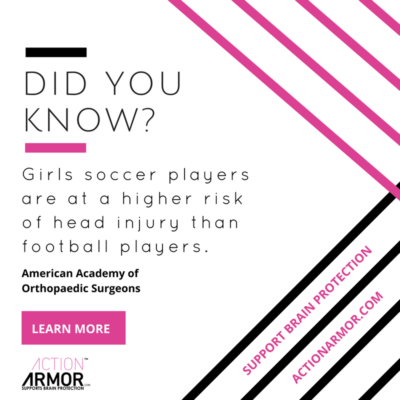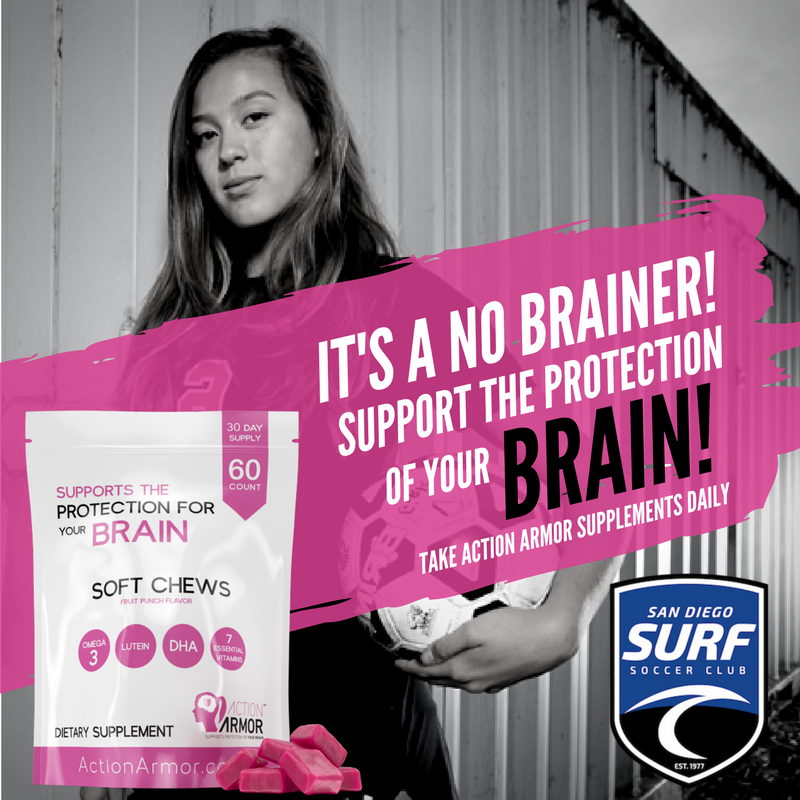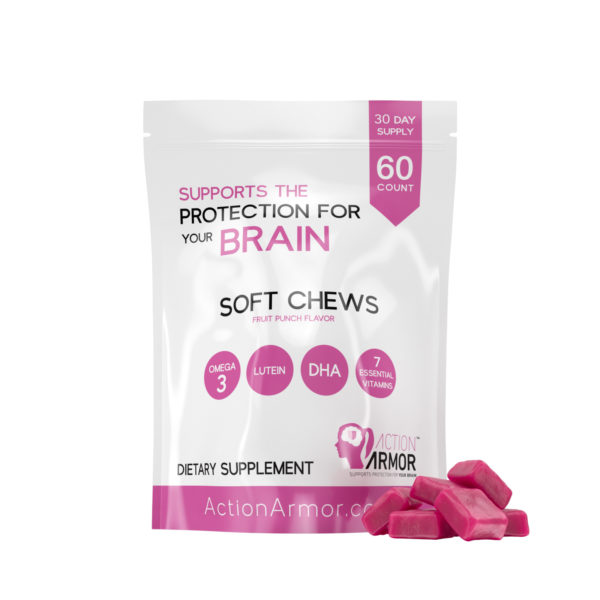Concussions: Can Dietary Supplements Really Make a Difference?
A Leading the Way Forward Special Feature on ACTION ARMOR’s Chews for Soccer Players
Even if it only helps a little — With the threat of concussions looming every time a youth soccer player takes to the field, can a small raspberry colored chew make a difference? That is what we wanted to know. How does it work? Does it work? We asked Thomas Kinder, Chief Executive Officer of Action Armor, for the answers.

Youth Soccer News: Concussions and other head-related injuries are a huge concern to parents, coaches, and players. Years ago, it was football that made the headlines with stories on the long-term brain damage suffered by players. While soccer is not considered a contact sport like football, the beautiful game is recognized by brain trauma scientists to pose a real threat for concussions. With it’s strong, g-force head to head impact, there has been a substantial rise in soccer-related concussions.
In fact, Female soccer players suffer the most concussions in high school sports
According to a new study which found a significant increase in overall reported concussions since traumatic brain injury laws were enacted, high school girls have a significantly higher concussion rate than boys. Female soccer players suffer the most concussions, according to new research presented at the 2017 Annual Meeting of the American Academy of Orthopaedic Surgeons (AAOS).
Approximately 300,000 adolescents suffer concussions, or mild traumatic brain injuries (TBI), each year while participating in high school sports. More youth soccer players are injured playing competitive club soccer.
What can be done? SoccerToday’s Diane Scavuzzo interviewed Thomas Kinder, Chief Executive Officer of Action Armor who has 26 years of experience in the healthcare industry.
Kinder became CEO in October 2017 and is focusing his expert energies on spreading the word on their dietary supplement developed to “Support the Protection of your Brain” with evidence-based nutrients to reduce the inflammatory response to injury along with support to help cognitive function.
How does it work? Does it really work? These and other questions are answered in this exclusive interview.
Diane Scavuzzo: What can we do to try to keep our players as safe from concussions as possible?
Thomas Kinder: While nothing can eliminate the potential injury of a concussion, new research does show that there are things that we can do to help protect our brains.
When you think of concussions, you almost certainly think of football first. Yet, a new study shows that football has the second-highest per capita rate of concussions and traumatic brain injuries in specific high school sports.
The top number? Girls soccer, by a significant amount.
 The findings from the study “Sport-and Gender-specific Trends in the Epidemiology of Concussions Suffered by High School Athletes” found that roughly 27 percent of all injuries suffered by girls soccer players are traumatic brain injuries (TBI).
The findings from the study “Sport-and Gender-specific Trends in the Epidemiology of Concussions Suffered by High School Athletes” found that roughly 27 percent of all injuries suffered by girls soccer players are traumatic brain injuries (TBI).
That’s a staggering percentage, particularly for a sport that also features a high incidence rate of knee injuries.
The study, led by Dr. Wellington Hsu, professor of orthopedics at Northwestern University’s Feinberg School of Medicine, was presented at the American Academy of Orthopaedic Surgeons (AAOS) annual conference.
From the study: The concussion rate for girls soccer is also increasing rapidly, and is now nearly tied with boys football and is 3-fold higher than boys’ soccer.
Diane Scavuzzo: Can nutrition or dietary supplements make a difference — if so, how? Why is the brain so susceptible to concussion?
Thomas Kinder: The brain is made of fat, and about 30 percent of that fat is what is called omega-3 fatty acids.
Omega-3s have many important, critical functions.
The Omega-3 Protocol states that if we saturate the brain with what it is made of, and we help create the nutritional foundation for the brain to heal, and it will heal.
Diane Scavuzzo: Can you explain that a bit?
Thomas Kinder: Think of a brick wall. If you have a brick wall that gets damaged, you probably want to use bricks to repair the wall.
Omega-3s are, literally, the bricks of the brain.
Omega-3s make up a significant part of every neuron cell membrane. There is no cure for concussion and TBI. There are no magic medicines, nor will there ever be. The brain must heal itself. But what we can do is optimize the conditions to help the brain do the healing. That is what using omega-3s will do.
 They provide a tool, the basic building block, for the brain to recover.
They provide a tool, the basic building block, for the brain to recover.
Diane Scavuzzo: When eating a healthy, athlete-oriented diet, do youth soccer players eat enough Omega-3?
Thomas Kinder: It would be great if we all ate enough foods high in omega-3s, but we don’t.
The problem is that omega-6 fatty acids are even more abundant in nature and in our food supply. While omega-3s are anti-inflammatory and pro-resolving, increase blood flow, and enhance the immune system, omega-6s promote inflammation, increase blood clotting, and depress the immune system.
Humans evolved consuming a diet that contained approximately equal amounts of omega-3 and omega-6 fatty acids.
About a hundred years ago, the industrial revolution introduced technology that refined vegetable oils. At the same time, there was a meteoric rise in the production and consumption of processed foods. Both led to a dramatic increase in the consumption of omega-6 fatty acids.
 In addition, the introduction of animal feeds derived from grains rich in omega-6 fats has resulted in the production of meat, fish, and eggs high in omega-6 fatty acids and virtually devoid of omega-3 fatty acids.
In addition, the introduction of animal feeds derived from grains rich in omega-6 fats has resulted in the production of meat, fish, and eggs high in omega-6 fatty acids and virtually devoid of omega-3 fatty acids.
Today, in Western diets, the ratio of omega-6 to omega-3 fatty acids ranges from 20:1 to 30:1 instead of the pre-industrial range of 1:1 to 2:1.
Research has shown that this imbalanced intake of omegas is a contributing factor to many chronic health conditions such as heart disease, diabetes, arthritis, depression, asthma, allergies, and obesity.
Diane Scavuzzo: Why is this information just coming to light now?
Thomas Kinder: It has been widely known for years that fish oil (Omega 3/ DHA) is healthy for brain, heart, and joints.
It is also known that the typical US diet does not incorporate enough fish to meet recommendations. This is particularly true with adolescents.
Diane Scavuzzo: Why a soft chew?
Thomas Kinder: Ease of use daily, and it tastes good and is pleasant to take.
It is almost like a snack.
The supplements are not the dreaded pills capsules with less than optimal taste which adds to the difficulty of adherence. There is that great, old slogan, “If the nutrients aren’t taken, they are guaranteed not to work.”
 Diane Scavuzzo: What are the anti-inflammatory properties of the supplement?
Diane Scavuzzo: What are the anti-inflammatory properties of the supplement?
Thomas Kinder: Athletes are always looking for ways to reduce inflammation.
The US diet is full of Omega 6’s no matter if you eat organic.
These are pro-inflammatory and so injuries are made worse. Our formula of Omega’s 3’s and DHA helps to combat this problem.
Diane Scavuzzo: Why do you think the is brain so susceptible to concussion? Why do more girls suffer concussions than boys?
Thomas Kinder: Weaker neck muscles, spatial awareness is slower to develop in girls – hence the Lutein in our chews and some data even shows that girls are more aggressive.
Diane Scavuzzo: As the CEO of Action Armor, what has been the biggest challenge so far? What is something people would be surprised to learn about you?
Thomas Kinder: Biggest challenge is educating parents and soccer coaches.
We are the first to the market so most consumers only know that head injury is an issue in football but now they are learning that head injuries are very common in other sports.
Most are aware that this an effort to make or improve equipment, change the rules of the games to try to reduce injury, but not aware that there are ways to help prepare the body for the potential of injury and in particular the brain. We are trying to make people aware that there is an easy and affordable way to help parents gain peace of mind as it relates to injury all the while benefitting them in the classroom with improved cognition and visual acuity.
We are trying to make people aware that there is an easy and affordable way to help parents gain peace of mind as it relates to injury all the while benefitting them in the classroom with improved cognition and visual acuity.
I am a parent of 2 boys that have played many sports but both settled on tackle football.
They both played at the D-1 level at Wyoming and UCLA. We were aware that head injury has always been a possibility but their desire to play, their development of the discipline needed, and leadership skills they developed while playing football will carry them throughout their lives outweighed our concern of injury.
Diane Scavuzzo: What is something people would be surprised to learn about you?
Thomas Kinder: As a professional, I have been in healthcare for over three decades. I am accustomed to having to prove something works and gains legal market approval. I have taken the same approach to nutritional supplements industry.
Action Armor formulation combined with clinical data from many studies using elements of our product has earned us an approved, legal claim that we Support Brain Protection.
In addition, we have received certifications and approval by International Olympic Committees around the world that we are in compliance with the world anti-doping guidelines.
Our intention is to make sure that youth athletes stay active and learn the life lessons that can only come from sports while providing their parents a piece of mind that they have done everything to support the protection of their young athlete giving them at least a small piece of mind.
Brain Injuries Information. (n.d.).Brian Lewis, Retrieved September 14, 2017, from http://braincare.center/brain-injuries-information/







